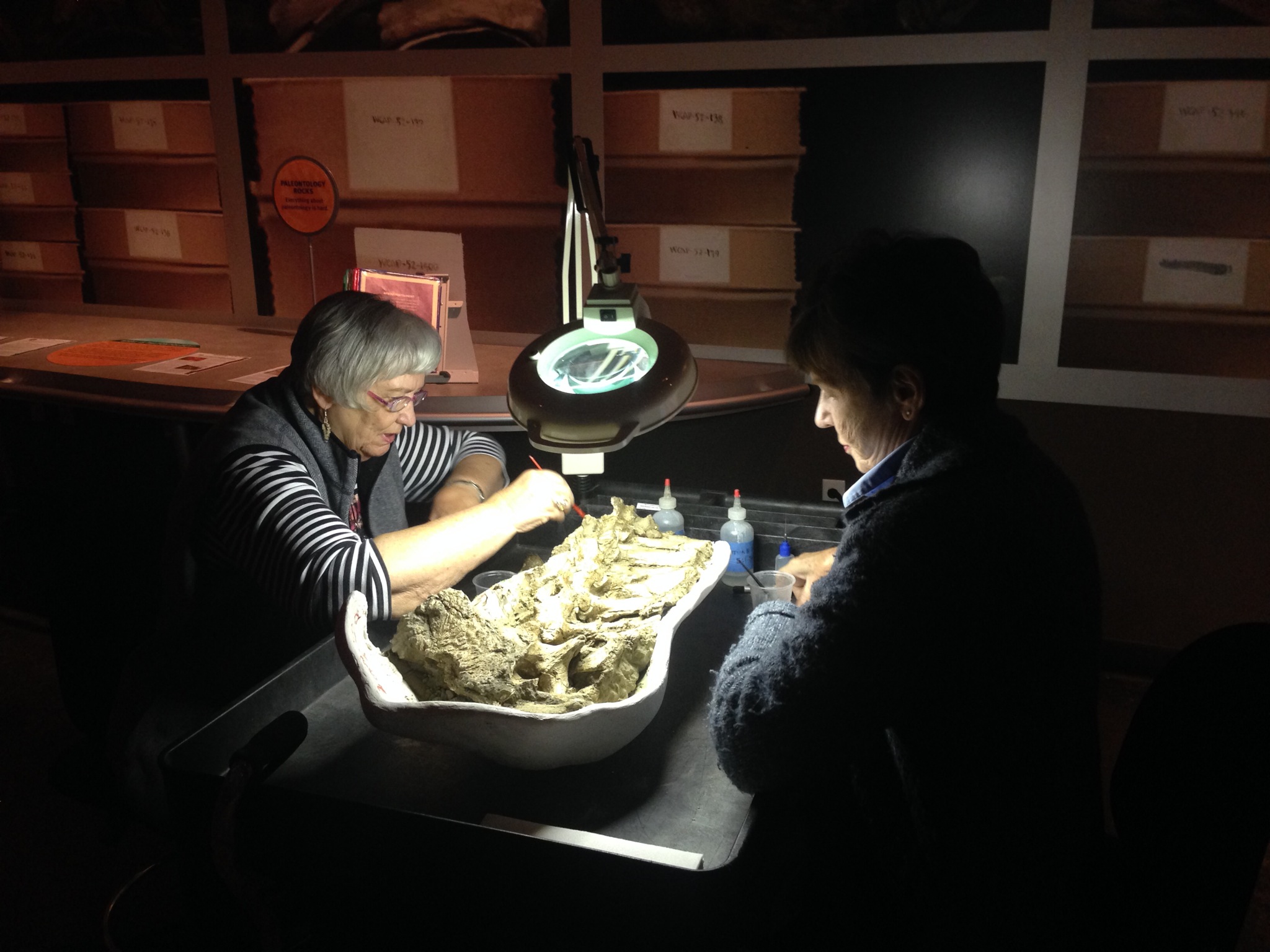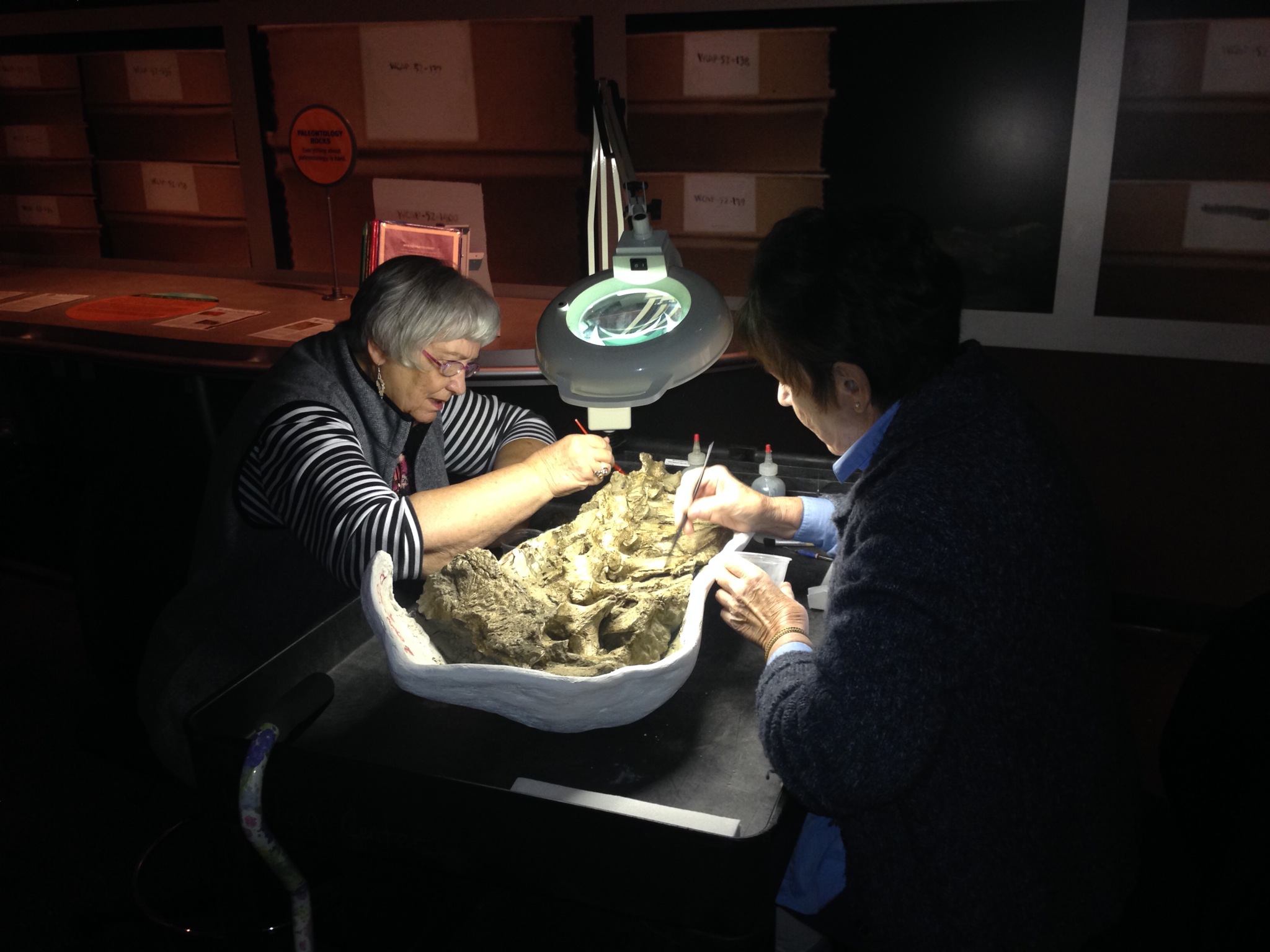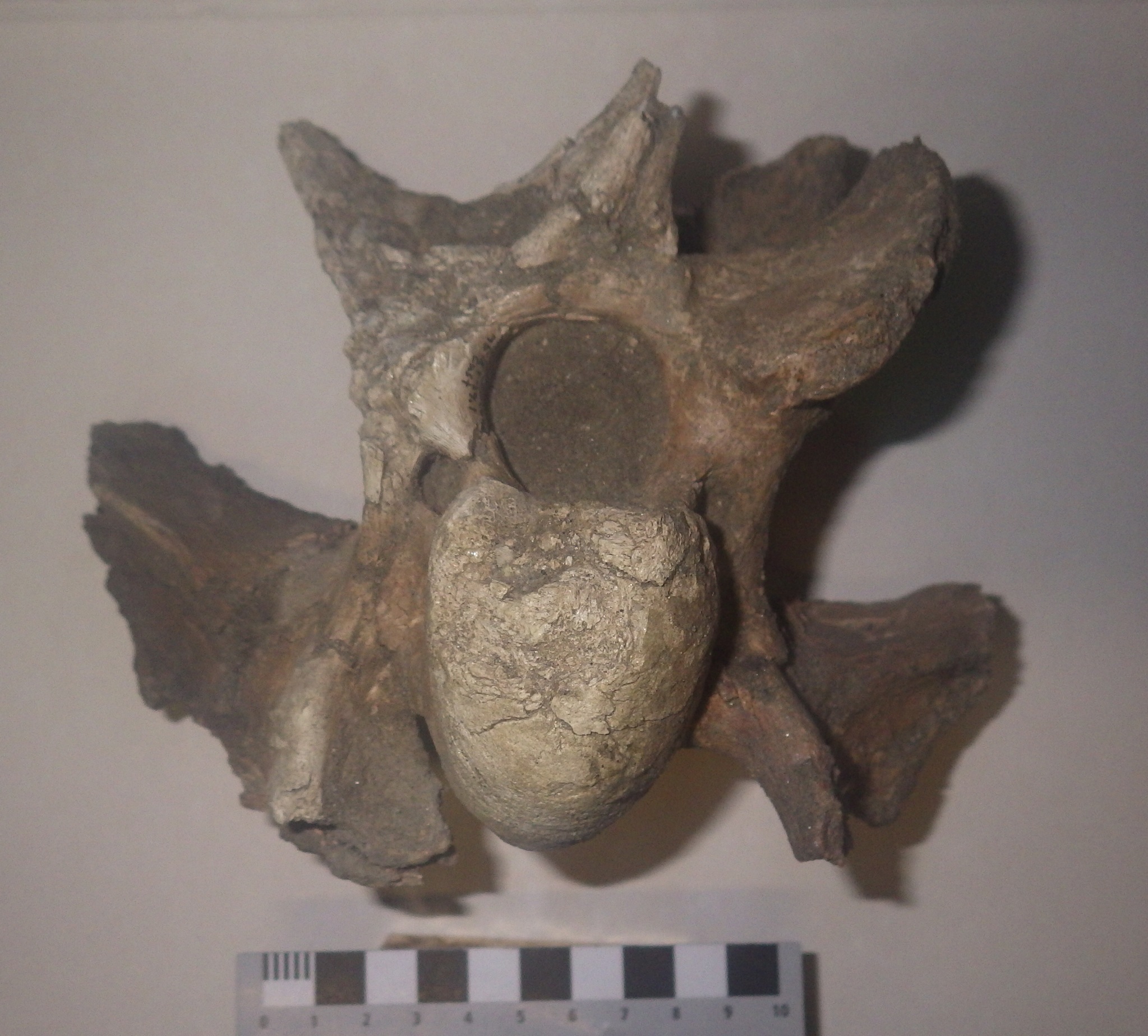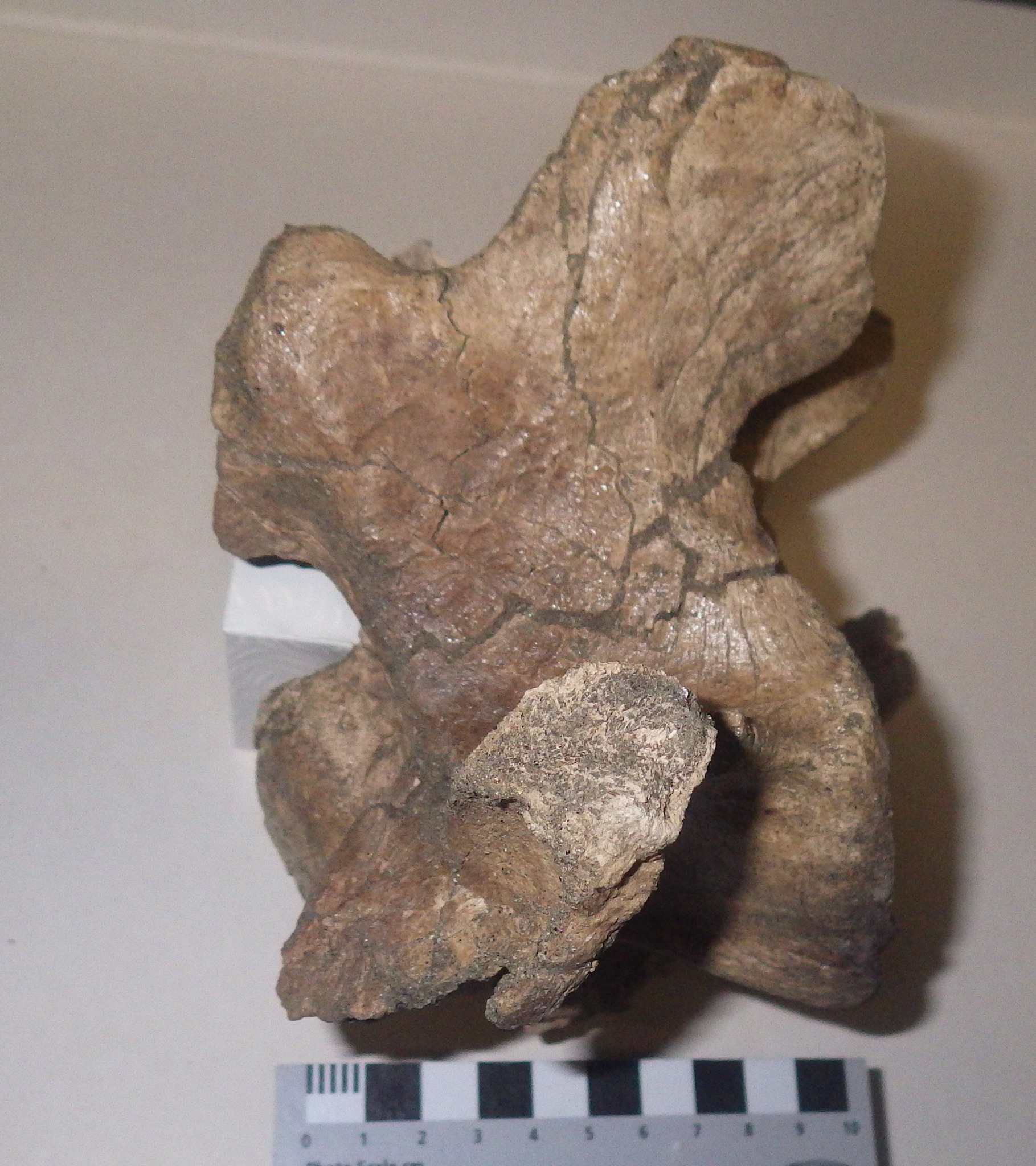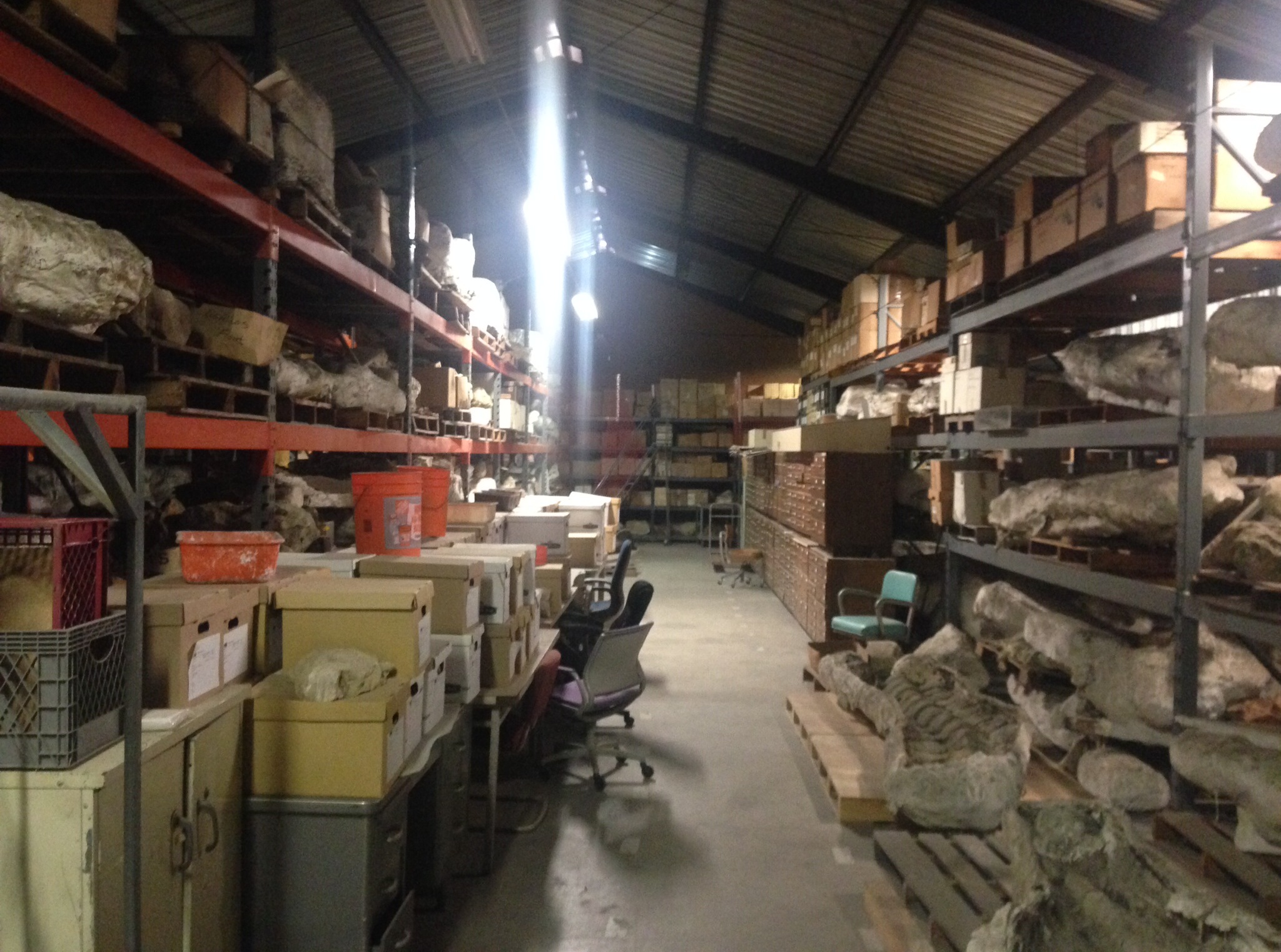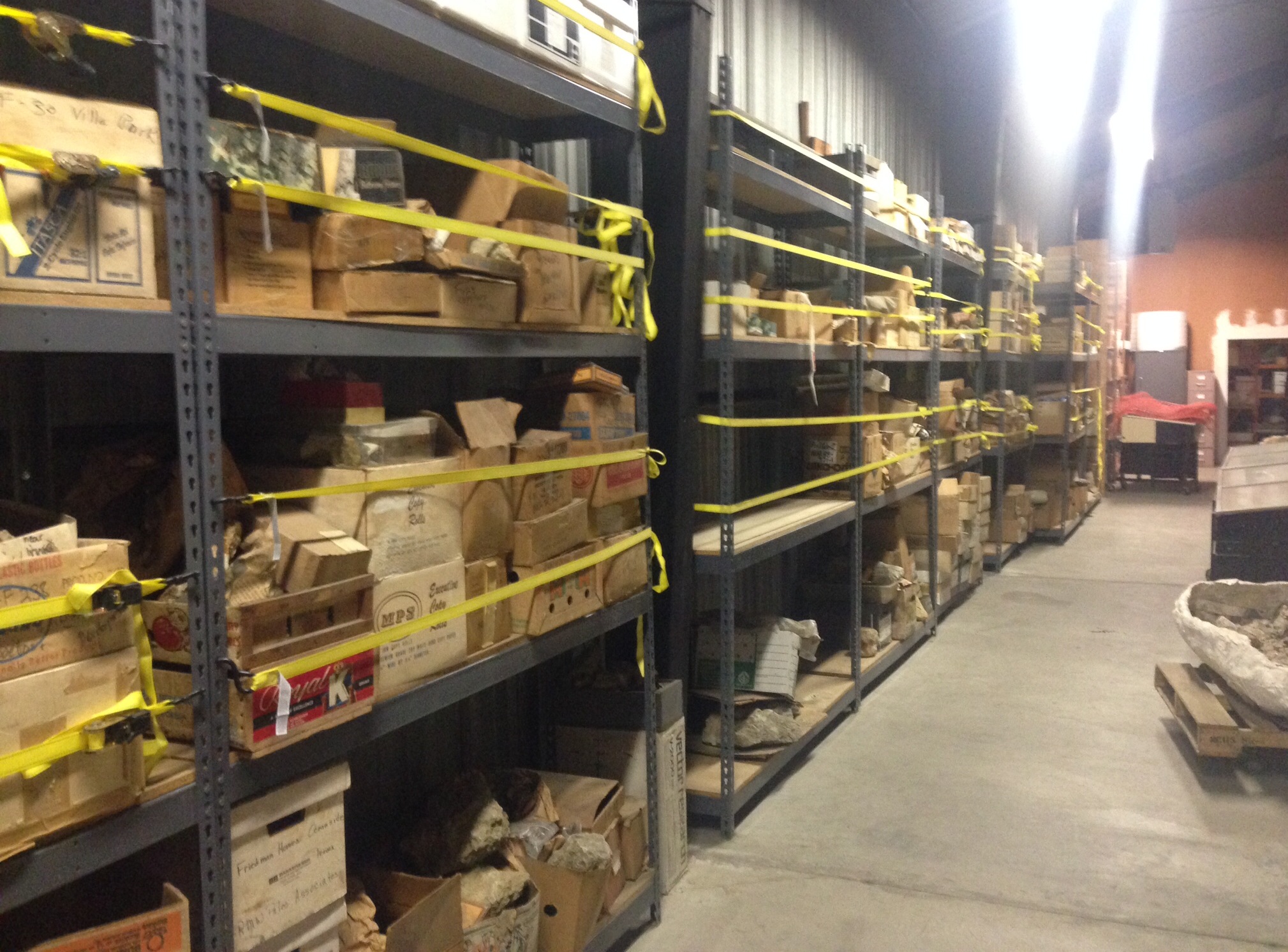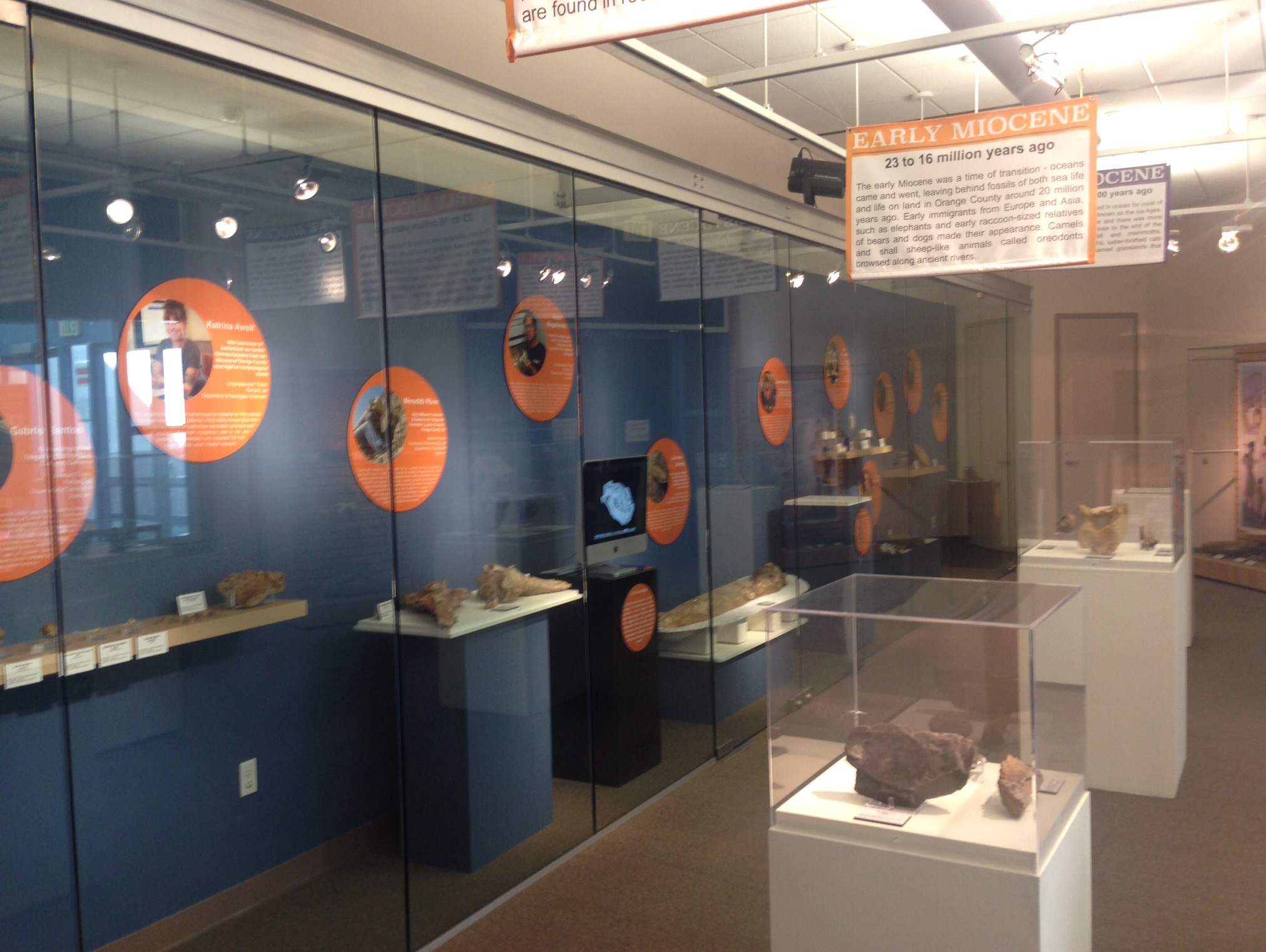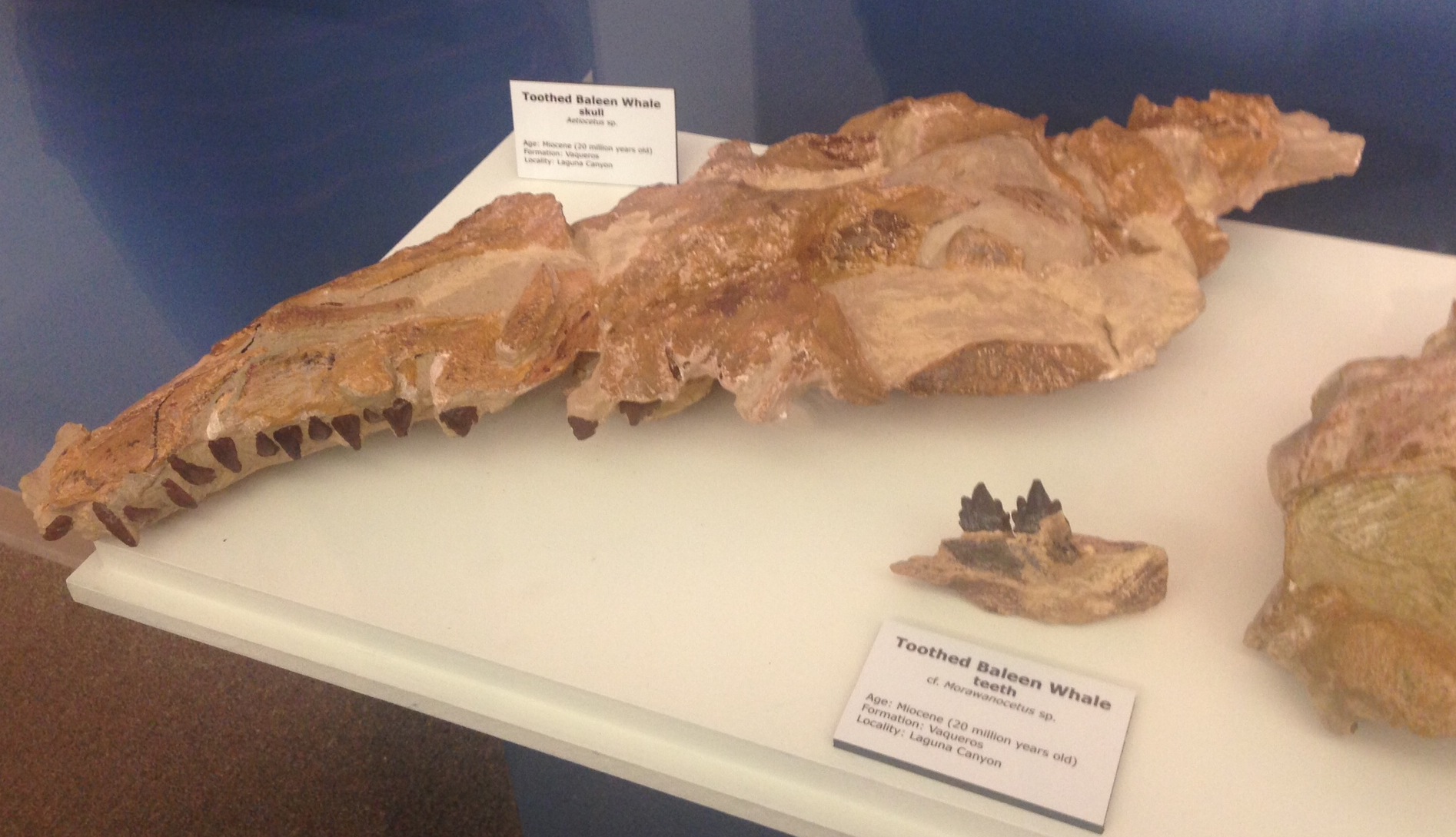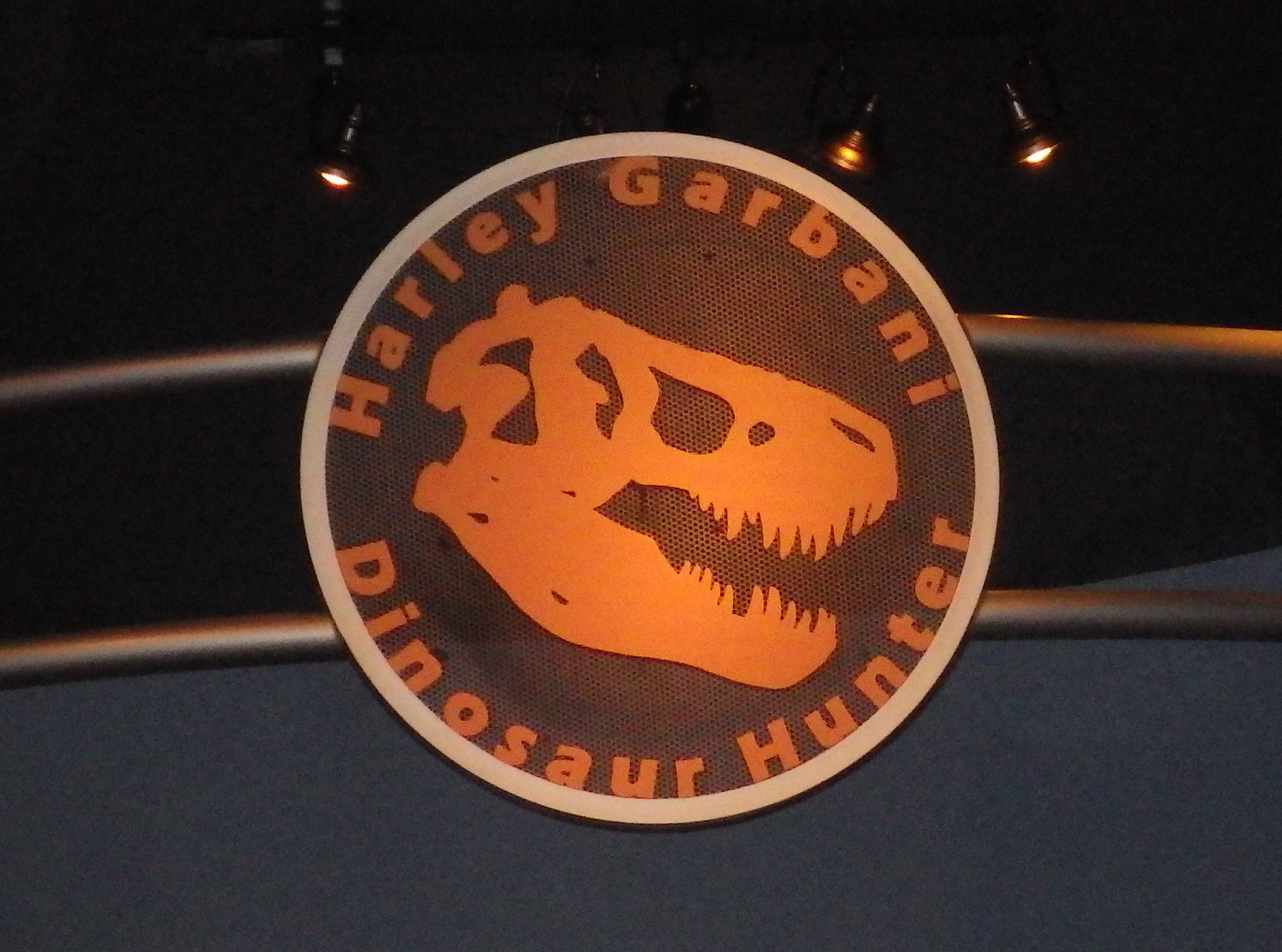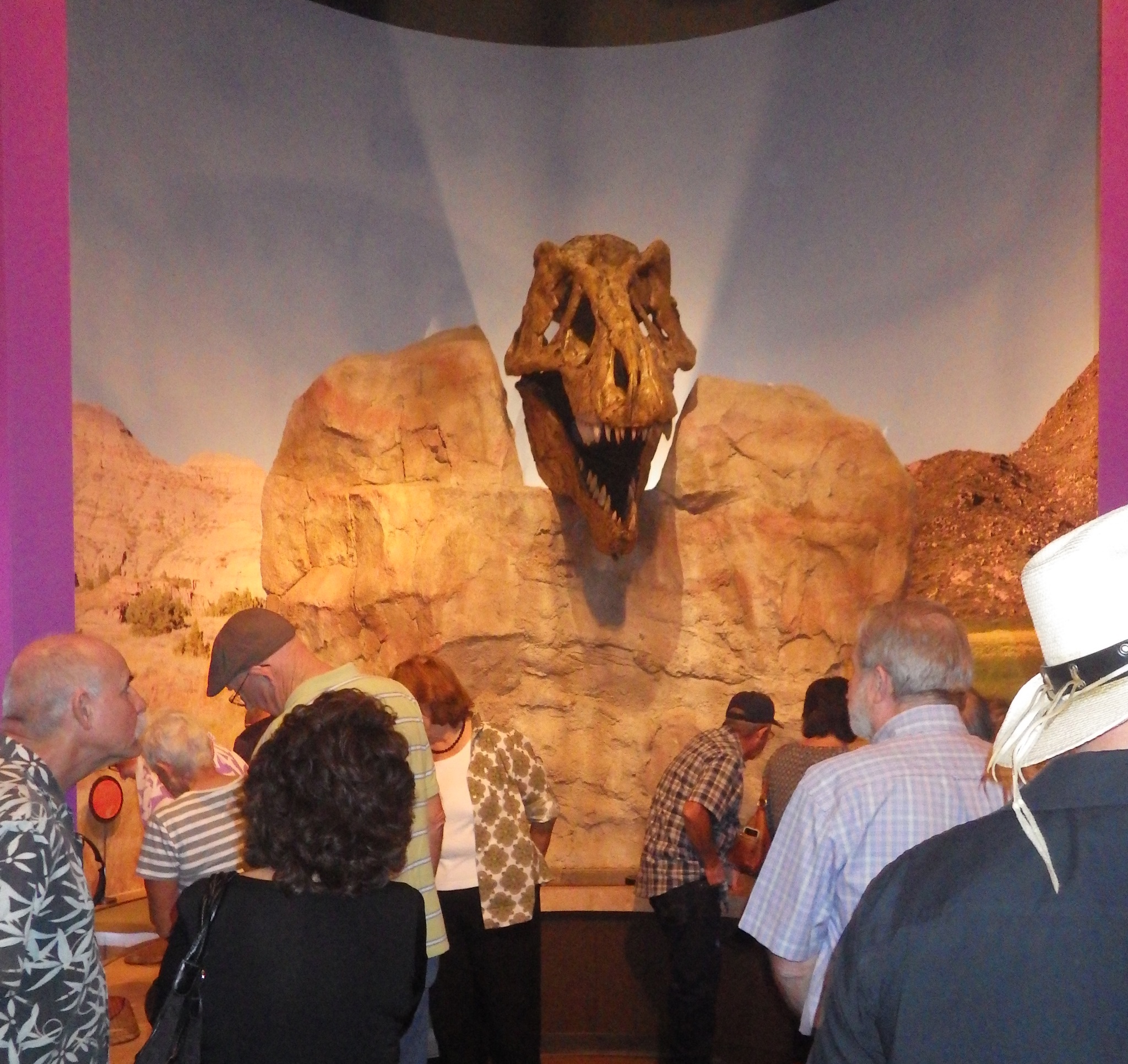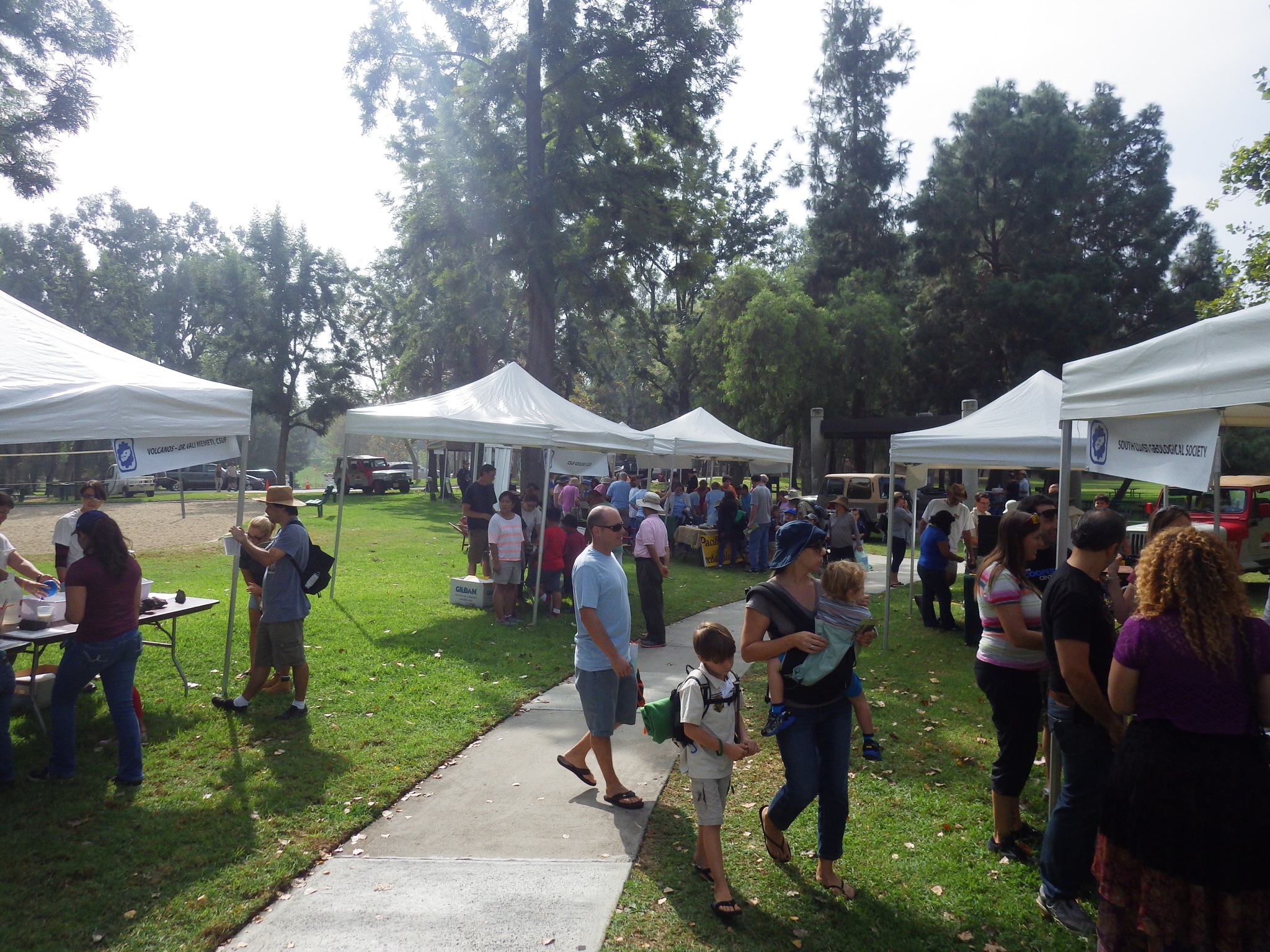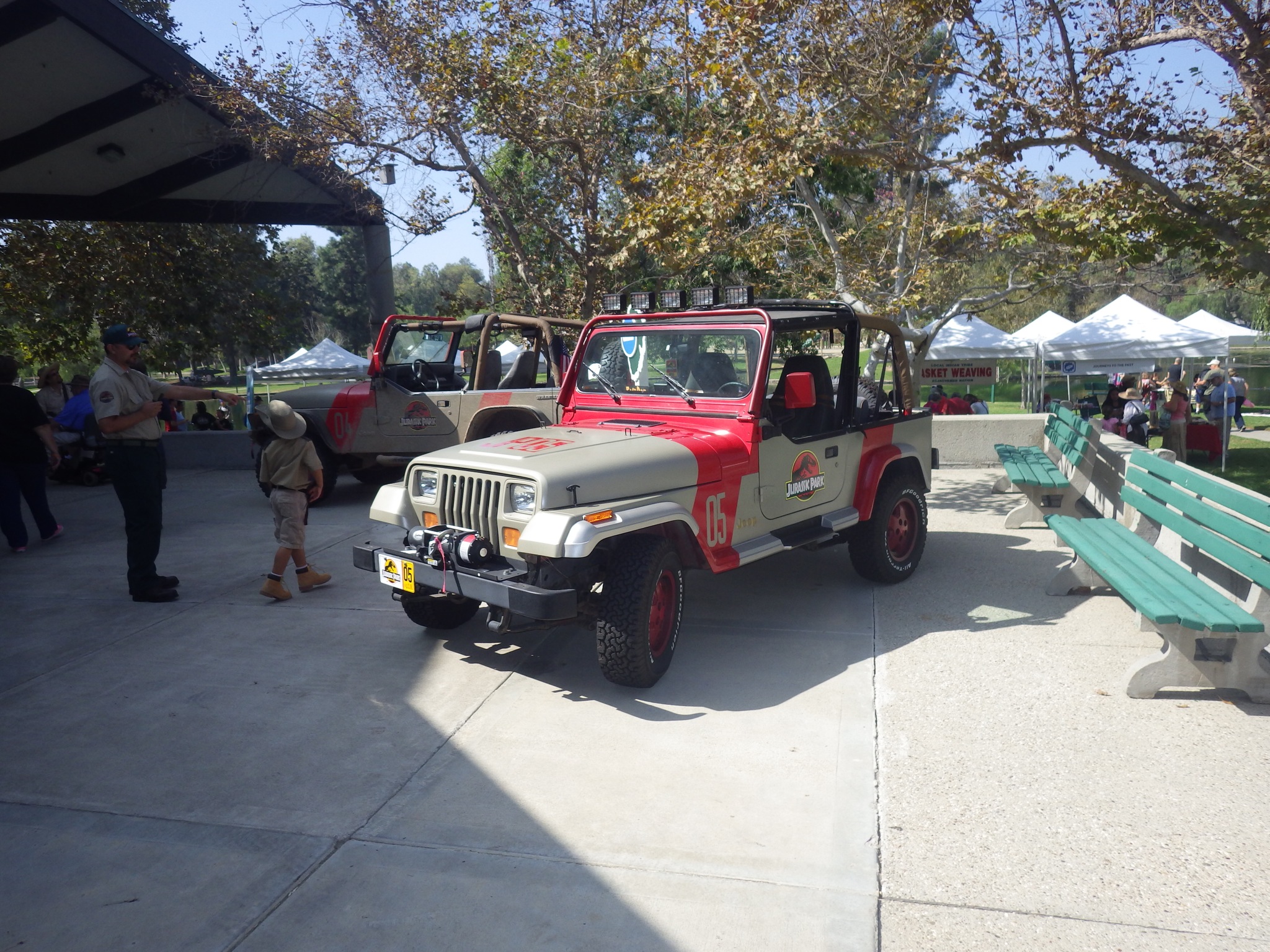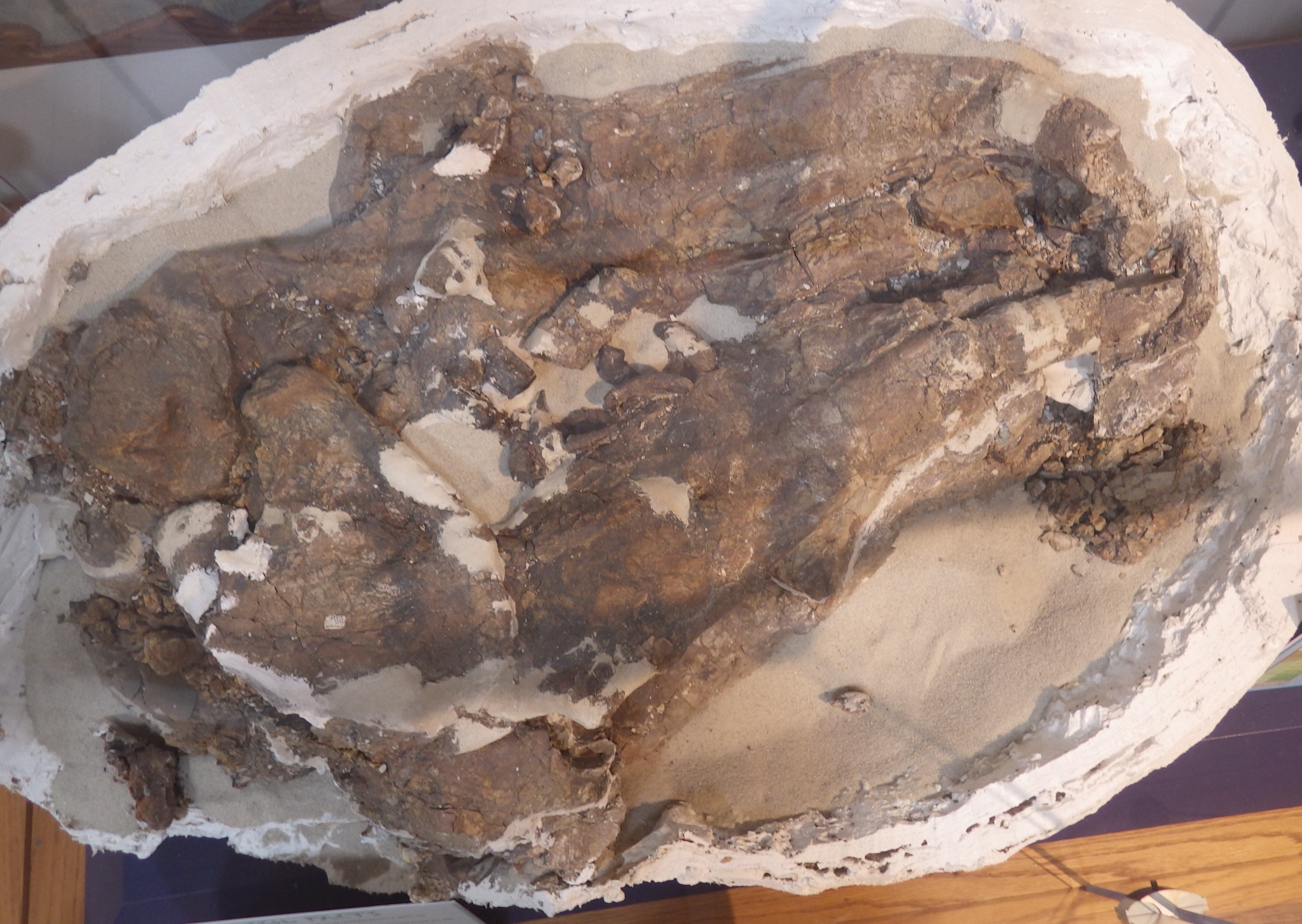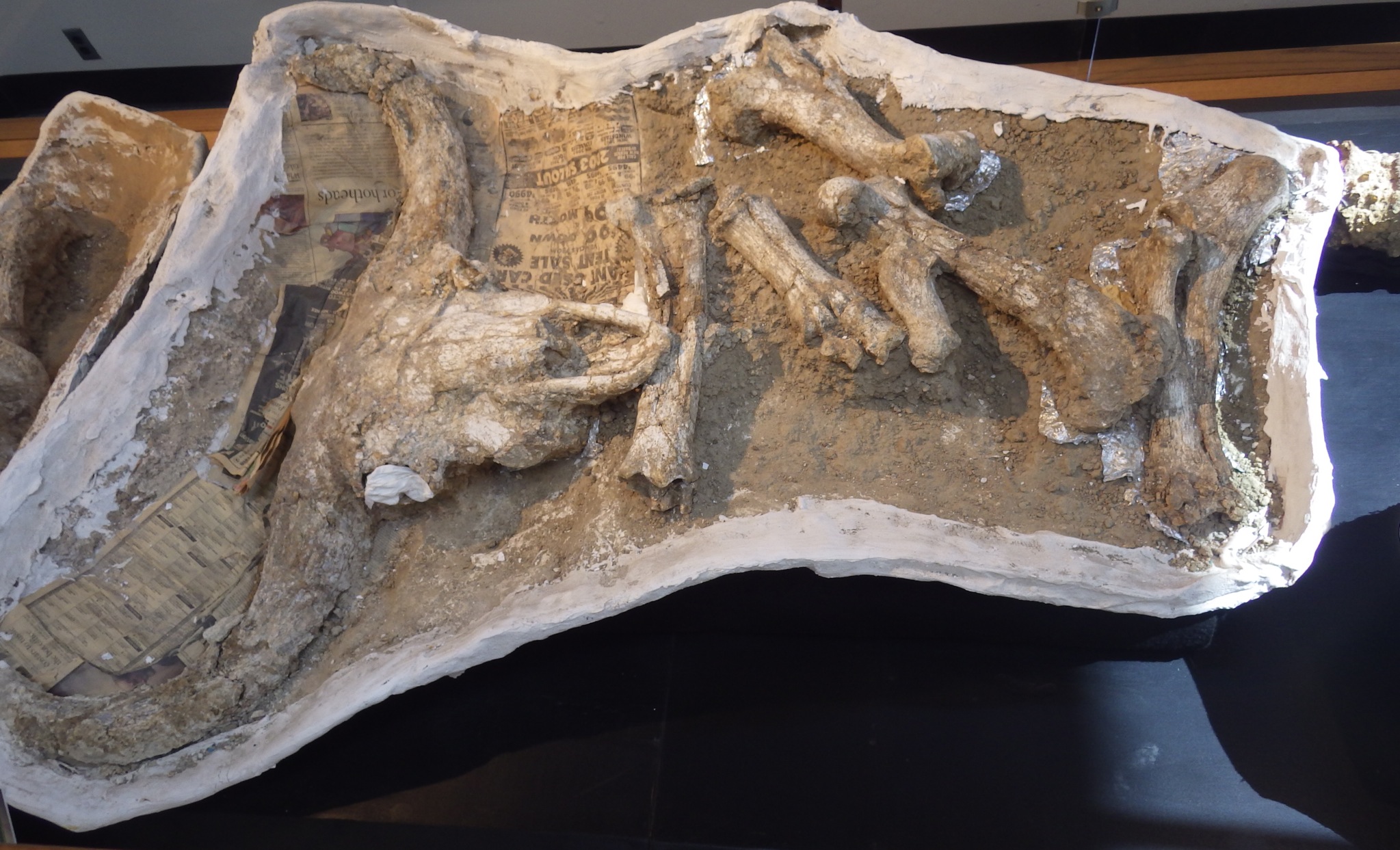 This morning Anthony Martin published a beautiful tribute at his blog Life Traces of the Georgia Coast, describing the importance of parental support and maximizing childhood opportunities in becoming a scientist, especially when growing up poor. Seemingly small acts of kindness and support can have dramatic and lasting effects. Reading his post, I was inspired to republish a post from my old blog, Updates from the Paleontology Lab. This was originally published in March 2011, on my 42nd birthday.I turned 42 years old today. According to Douglas Adams in The Hitchhiker’s Guide to the Galaxy, 42 is the answer to life, the universe, and everything – clearly an opportunity for self reflection if there ever was one. And since 42 is, after all, the answer to a question, it seems appropriate to address a question that I’m frequently asked by museum visitors (especially parents with young children) – why did I become a scientist?A full answer to that question would require much more than a blog post. (In fact, it would probably need a book, written by psychiatrists). But there are factors that are easily examined, including the information I was exposed to as a child.As I look at the breadth of resources available today online, it’s jarring when I consider how far information technology has come in my lifetime, and I don’t think it’s an exaggeration to say that the personal computer and the internet are the most significant human inventions since the printing press.I grew up poor in rural Virginia. The nearest natural history museum was the Smithsonian, 200 miles away; by the time I started high school I had managed to visit there twice. We lived too far from the city to get good PBS reception, although I did get to watch it when we visited my grandmother in Roanoke. So initially I depended on libraries for information. Even this was a challenge; Stewartsville Elementary School was 15 miles away, and the nearest public library was 30 miles away in Vinton, so I couldn’t exactly walk there whenever I wanted. But I found enough science-themed books to apparently influence me for life, and by the 1st or 2nd grade I knew I wanted to be a scientist. Three books in particular that I read around that time (1976-78) were very influential:Childcraft Worldbook 1976 Annual – Prehistoric AnimalsMy grandmother had a complete Worldbook Encyclopedia set, as well as the Childcraft “How and Why” Library. Included with that was a subscription to the Childcraft Annuals, which were on a different topic each year. In 1976, the topic was Prehistoric Animals.The Prehistoric Animals issue was wonderful. It went through all kinds of amazing creatures, including eurypterids, trilobites, and crinoids like the ones I collected as a child in the mountains of Botetourt and Craig Counties. I was introduced to the Geologic Time Scale for the first time. There were dramatic paintings that I would stare at for hours, and later attempt to copy; Dunkleosteus, Dimetrodon, all kinds of dinosaurs and mammals. Over the next few years I probably read the book cover to cover at least a dozen times.
This morning Anthony Martin published a beautiful tribute at his blog Life Traces of the Georgia Coast, describing the importance of parental support and maximizing childhood opportunities in becoming a scientist, especially when growing up poor. Seemingly small acts of kindness and support can have dramatic and lasting effects. Reading his post, I was inspired to republish a post from my old blog, Updates from the Paleontology Lab. This was originally published in March 2011, on my 42nd birthday.I turned 42 years old today. According to Douglas Adams in The Hitchhiker’s Guide to the Galaxy, 42 is the answer to life, the universe, and everything – clearly an opportunity for self reflection if there ever was one. And since 42 is, after all, the answer to a question, it seems appropriate to address a question that I’m frequently asked by museum visitors (especially parents with young children) – why did I become a scientist?A full answer to that question would require much more than a blog post. (In fact, it would probably need a book, written by psychiatrists). But there are factors that are easily examined, including the information I was exposed to as a child.As I look at the breadth of resources available today online, it’s jarring when I consider how far information technology has come in my lifetime, and I don’t think it’s an exaggeration to say that the personal computer and the internet are the most significant human inventions since the printing press.I grew up poor in rural Virginia. The nearest natural history museum was the Smithsonian, 200 miles away; by the time I started high school I had managed to visit there twice. We lived too far from the city to get good PBS reception, although I did get to watch it when we visited my grandmother in Roanoke. So initially I depended on libraries for information. Even this was a challenge; Stewartsville Elementary School was 15 miles away, and the nearest public library was 30 miles away in Vinton, so I couldn’t exactly walk there whenever I wanted. But I found enough science-themed books to apparently influence me for life, and by the 1st or 2nd grade I knew I wanted to be a scientist. Three books in particular that I read around that time (1976-78) were very influential:Childcraft Worldbook 1976 Annual – Prehistoric AnimalsMy grandmother had a complete Worldbook Encyclopedia set, as well as the Childcraft “How and Why” Library. Included with that was a subscription to the Childcraft Annuals, which were on a different topic each year. In 1976, the topic was Prehistoric Animals.The Prehistoric Animals issue was wonderful. It went through all kinds of amazing creatures, including eurypterids, trilobites, and crinoids like the ones I collected as a child in the mountains of Botetourt and Craig Counties. I was introduced to the Geologic Time Scale for the first time. There were dramatic paintings that I would stare at for hours, and later attempt to copy; Dunkleosteus, Dimetrodon, all kinds of dinosaurs and mammals. Over the next few years I probably read the book cover to cover at least a dozen times. Danny Dunn and the Fossil Cave, by Raymond Abrashkin and Jay Williams
Danny Dunn and the Fossil Cave, by Raymond Abrashkin and Jay Williams The Danny Dunn books were a series of science-themed children’s novels in which three children (Danny Dunn, Irene Miller, and Joe Pearson) became involved in various science and technology adventures. Danny’s mother was a live-in housekeeper for Professor Bullfinch, who was a kind of generic scientist/inventor, while Irene’s father was an astronomer. Fossil Cave was the first Danny Dunn book I read (although it was the sixth in the series). In the story they discovered a dinosaur skeleton buried in a nearby cave using what was essentially a portable CT scanner. I was enthralled (the fact that I totally had a crush on Irene probably helped), and immediately checked out all the Danny Dunn books I could find. I eventually found and read six of the 15 books in the series. The Nine Planets, by Franklyn M. Branley
The Danny Dunn books were a series of science-themed children’s novels in which three children (Danny Dunn, Irene Miller, and Joe Pearson) became involved in various science and technology adventures. Danny’s mother was a live-in housekeeper for Professor Bullfinch, who was a kind of generic scientist/inventor, while Irene’s father was an astronomer. Fossil Cave was the first Danny Dunn book I read (although it was the sixth in the series). In the story they discovered a dinosaur skeleton buried in a nearby cave using what was essentially a portable CT scanner. I was enthralled (the fact that I totally had a crush on Irene probably helped), and immediately checked out all the Danny Dunn books I could find. I eventually found and read six of the 15 books in the series. The Nine Planets, by Franklyn M. Branley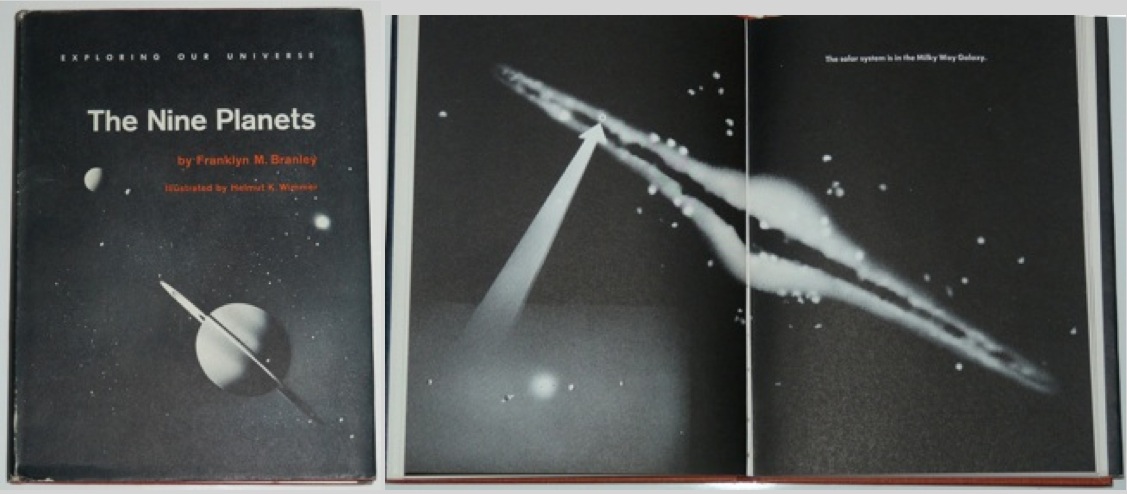 This was a non-fiction science book, again aimed at children. I was already interested in dinosaurs from the Childcraft books. But upon discovering that they were extinct it occurred to me that maybe they were only extinct on Earth, and could still be living on other planets (give me a break, I was in 2nd grade!). I checked out and read The Nine Planets in order to find out.Some of the concepts in The Nine Planets were a bit beyond me at that age, but it was enough to confirm that dinosaurs were unlikely on other planets, and to get me interested in astronomy. That interest has continued, and I didn’t choose between astronomy, paleontology, and field biology until I was in college. All About Whales, by Roy Chapman Andrews
This was a non-fiction science book, again aimed at children. I was already interested in dinosaurs from the Childcraft books. But upon discovering that they were extinct it occurred to me that maybe they were only extinct on Earth, and could still be living on other planets (give me a break, I was in 2nd grade!). I checked out and read The Nine Planets in order to find out.Some of the concepts in The Nine Planets were a bit beyond me at that age, but it was enough to confirm that dinosaurs were unlikely on other planets, and to get me interested in astronomy. That interest has continued, and I didn’t choose between astronomy, paleontology, and field biology until I was in college. All About Whales, by Roy Chapman Andrews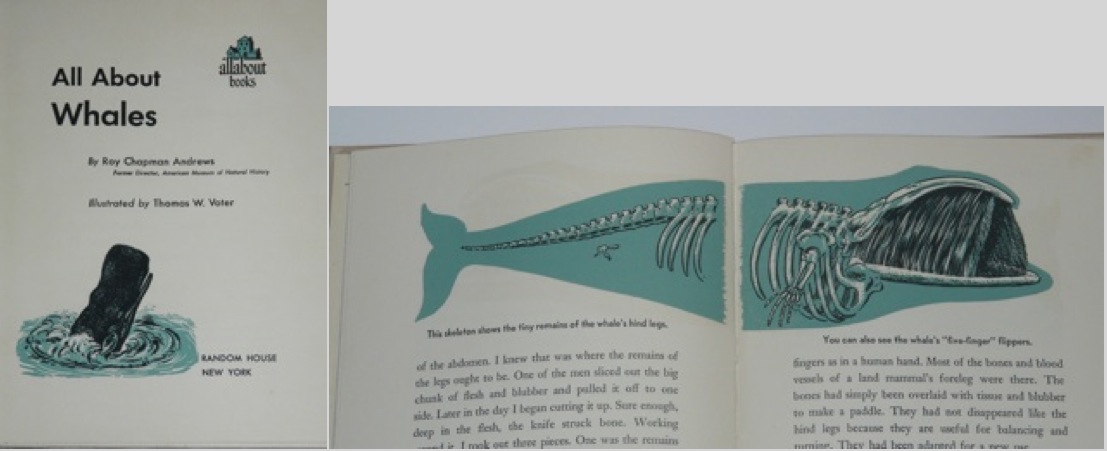 When I first read this book I had no idea that Roy Chapman Andrews was one of the most famous of all paleontologists. Year later, while in graduate school I saw a copy in a library discard sale and I finally made the connection. Andrews’ children’s books are fun reads. All About Whales has some chapters that go into a fair amount of detail about whale skeletal anatomy and others in which he talks about accompanying whalers on a hunt and having to fight off sharks after ending up in the water. This book actually influenced me twice; as a child it reinforced the idea of science as an adventure in learning, and as an adult it helped me realize the influence a scientist could have by making their research accessible to everyone.By the end of the 2nd grade I was completely hooked on science. I read every paleontology and astronomy book I could find in my school’s library and the public library in Vinton (we started driving out there every few weeks). This broadened my reading selection considerably. The Lost World, by Sir Arthur Conan Doyle
When I first read this book I had no idea that Roy Chapman Andrews was one of the most famous of all paleontologists. Year later, while in graduate school I saw a copy in a library discard sale and I finally made the connection. Andrews’ children’s books are fun reads. All About Whales has some chapters that go into a fair amount of detail about whale skeletal anatomy and others in which he talks about accompanying whalers on a hunt and having to fight off sharks after ending up in the water. This book actually influenced me twice; as a child it reinforced the idea of science as an adventure in learning, and as an adult it helped me realize the influence a scientist could have by making their research accessible to everyone.By the end of the 2nd grade I was completely hooked on science. I read every paleontology and astronomy book I could find in my school’s library and the public library in Vinton (we started driving out there every few weeks). This broadened my reading selection considerably. The Lost World, by Sir Arthur Conan Doyle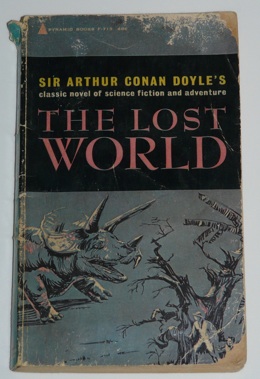 I believe I first read Doyle’s famous book after checking a copy out of the public library. I found myself wishing for the characters to have more encounters with the dinosaurs so I could read more detailed descriptions. It bothered me greatly that there was almost no description of the aquatic creatures in the Central Lake. It’s probably also informative that I found the scientists vastly more interesting than either Roxton or Malone and that, while I found Professor Challenger impressive and amusing, the character I most identified with was Professor Summerlee.Starting around 1980 I found another source of books; flea markets. Paperback books and magazines would generally sell for somewhere between a nickel and a quarter, and while rural Virginia flea markets were not exactly hotbeds of scientific literature, there were some things to choose from.For many decades Isaac Asimov wrote a monthly science column for the Magazine of Fantasy and Science Fiction. A subscription to F&SF was way out of my financial league, but many of Asimov’s essays were republished in paperback compilations; these would sometimes turn up at the flea markets, and I ended up with perhaps 8-10 different compilations. While the majority of these essays were on astronomy topics, Asimov was a biochemist and an eclectic writer, and the topics often involved chemistry, biology, physics, and science history.
I believe I first read Doyle’s famous book after checking a copy out of the public library. I found myself wishing for the characters to have more encounters with the dinosaurs so I could read more detailed descriptions. It bothered me greatly that there was almost no description of the aquatic creatures in the Central Lake. It’s probably also informative that I found the scientists vastly more interesting than either Roxton or Malone and that, while I found Professor Challenger impressive and amusing, the character I most identified with was Professor Summerlee.Starting around 1980 I found another source of books; flea markets. Paperback books and magazines would generally sell for somewhere between a nickel and a quarter, and while rural Virginia flea markets were not exactly hotbeds of scientific literature, there were some things to choose from.For many decades Isaac Asimov wrote a monthly science column for the Magazine of Fantasy and Science Fiction. A subscription to F&SF was way out of my financial league, but many of Asimov’s essays were republished in paperback compilations; these would sometimes turn up at the flea markets, and I ended up with perhaps 8-10 different compilations. While the majority of these essays were on astronomy topics, Asimov was a biochemist and an eclectic writer, and the topics often involved chemistry, biology, physics, and science history.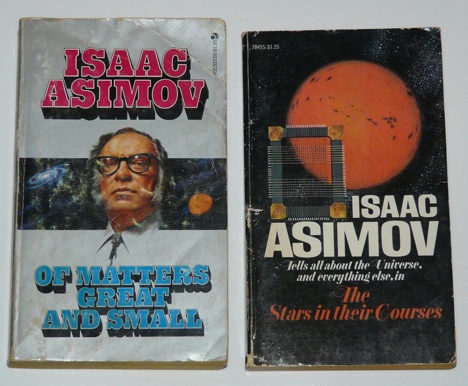 The other thing that frequently showed up at the flea markets were back issues of National Geographic. Almost every issue would include at least one article related to science in some way, and I would dig through boxes picking out the ones that looked most promising (at 5 or 10 cents each, I could only afford a few at a time). Then one year, around 1980, I hit the jackpot. Someone had been selling a huge collection of Nat Geos, perhaps 150-200 issues. They were asking 25 cents for each one, which was out of my price range. But at the end of the day, they took everything they hadn’t sold (nearly all of them) and threw them in the dumpster. My sister spotted them as we were leaving, and Mom stopped the car while I climbed in the dumpster and pulled out 10 boxes of Nat Geos.Four National Geographic issues in particular always stood out for me.August 1978New Ideas about Dinosaurs, by John Ostrom
The other thing that frequently showed up at the flea markets were back issues of National Geographic. Almost every issue would include at least one article related to science in some way, and I would dig through boxes picking out the ones that looked most promising (at 5 or 10 cents each, I could only afford a few at a time). Then one year, around 1980, I hit the jackpot. Someone had been selling a huge collection of Nat Geos, perhaps 150-200 issues. They were asking 25 cents for each one, which was out of my price range. But at the end of the day, they took everything they hadn’t sold (nearly all of them) and threw them in the dumpster. My sister spotted them as we were leaving, and Mom stopped the car while I climbed in the dumpster and pulled out 10 boxes of Nat Geos.Four National Geographic issues in particular always stood out for me.August 1978New Ideas about Dinosaurs, by John Ostrom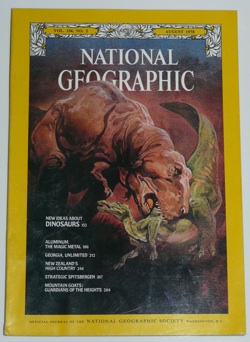 By the time I obtained this issue, I had read dozens of children’s books on dinosaurs. I also loved watching Land of the Lost on Saturday mornings. All of these sources portrayed a very consistent image of dinosaurs as little more than giant, spiky lizards that hung out in swamps all day (although the Tyrannosaurus in Land of the Lost was remarkably quick and agile). In other words, the stuff I was reading in the 1970’s was based on the science of the 1950’s, or even earlier. Ostrom’s article was the first thing I had read that showed paleontology as a dynamic science that was discovering more than just new species. Some of the things in my books could be wrong, and there were still lots of new things to discover.December 1976The Imperiled Giants, by William Graves and Exploring the Lives of Whales, by Victor SchefferJanuary 1979Humpbacks: The Gentle Giants, by Sylvia Earle and Humpbacks: Their Mysterious Songs, by Roger Payne
By the time I obtained this issue, I had read dozens of children’s books on dinosaurs. I also loved watching Land of the Lost on Saturday mornings. All of these sources portrayed a very consistent image of dinosaurs as little more than giant, spiky lizards that hung out in swamps all day (although the Tyrannosaurus in Land of the Lost was remarkably quick and agile). In other words, the stuff I was reading in the 1970’s was based on the science of the 1950’s, or even earlier. Ostrom’s article was the first thing I had read that showed paleontology as a dynamic science that was discovering more than just new species. Some of the things in my books could be wrong, and there were still lots of new things to discover.December 1976The Imperiled Giants, by William Graves and Exploring the Lives of Whales, by Victor SchefferJanuary 1979Humpbacks: The Gentle Giants, by Sylvia Earle and Humpbacks: Their Mysterious Songs, by Roger Payne For many years National Geographic seemed to have a special relationship with whale research, and they published numerous articles on whales in the 1970’s. These two issues really stood out for me. One presented an overview of all different species of whales, and I realized that even among living animals there was much greater diversity than I had realized. The other focused on humpback whales, and is the issue that included the famous whale song record as a plastic insert (I think this is the only record Nat Geo ever released). This got into some of the nitty-gritty of whale research, and emphasized that a lot things were still unknown. I should emphasize that these articles (and Andrews’ book) didn’t directly lead to me working on fossil whales, but they probably helped me make that transition more easily years later.January 1980What Voyager Saw: Jupiter’s Dazzling Realm, by Rick Gore
For many years National Geographic seemed to have a special relationship with whale research, and they published numerous articles on whales in the 1970’s. These two issues really stood out for me. One presented an overview of all different species of whales, and I realized that even among living animals there was much greater diversity than I had realized. The other focused on humpback whales, and is the issue that included the famous whale song record as a plastic insert (I think this is the only record Nat Geo ever released). This got into some of the nitty-gritty of whale research, and emphasized that a lot things were still unknown. I should emphasize that these articles (and Andrews’ book) didn’t directly lead to me working on fossil whales, but they probably helped me make that transition more easily years later.January 1980What Voyager Saw: Jupiter’s Dazzling Realm, by Rick Gore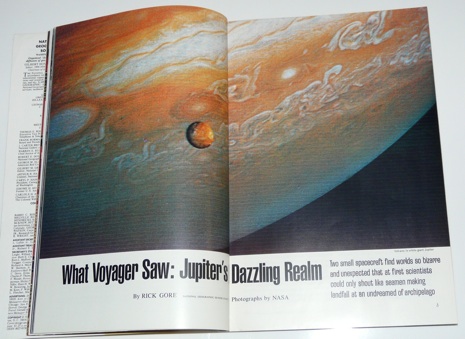 I can’t remember the Voyager spacecraft being launched, and in fact I don’t remember seeing a single news broadcast about their encounters (although there must have been some). So when I read the Nat Geo summary of the Jupiter encounters it was completely new to me. It seemed like practically everything I had read about the Solar System was terribly incomplete if not outright wrong. I also read that the Voyager probes were still going, with more encounters yet to come. I couldn’t wait!I can’t emphasize enough the impact Voyager had on me. After Jupiter revealed what Voyager could find, it was like getting science on a schedule. All we had to do was wait for Voyager to reach Saturn, and new discoveries were all but guaranteed. It seemed like all the efforts of all the scientists through the centuries had barely scratched the surface, and for me, emphasized science as an ongoing endeavor, not a body of facts.My interest in science was no secret among my family by the time I was in upper elementary school. Several of my relatives really supported this, including my parents, my grandmothers, and some of my father’s sisters. Around 1980, my Aunt Virginia joined some type of “Book of the Month” club. For several years, she used her club credits to buy me a science book each Christmas.
I can’t remember the Voyager spacecraft being launched, and in fact I don’t remember seeing a single news broadcast about their encounters (although there must have been some). So when I read the Nat Geo summary of the Jupiter encounters it was completely new to me. It seemed like practically everything I had read about the Solar System was terribly incomplete if not outright wrong. I also read that the Voyager probes were still going, with more encounters yet to come. I couldn’t wait!I can’t emphasize enough the impact Voyager had on me. After Jupiter revealed what Voyager could find, it was like getting science on a schedule. All we had to do was wait for Voyager to reach Saturn, and new discoveries were all but guaranteed. It seemed like all the efforts of all the scientists through the centuries had barely scratched the surface, and for me, emphasized science as an ongoing endeavor, not a body of facts.My interest in science was no secret among my family by the time I was in upper elementary school. Several of my relatives really supported this, including my parents, my grandmothers, and some of my father’s sisters. Around 1980, my Aunt Virginia joined some type of “Book of the Month” club. For several years, she used her club credits to buy me a science book each Christmas.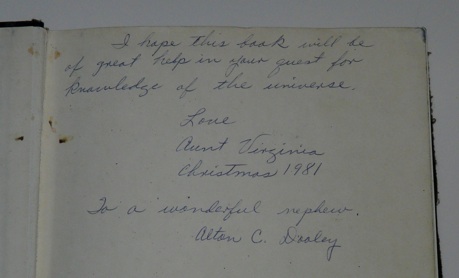 Cosmos, by Carl Sagan
Cosmos, by Carl Sagan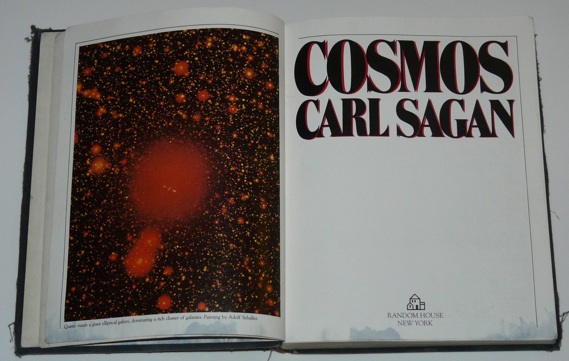 I read the book Cosmos before seeing the video series of the same name. Sagan did a great job emphasizing the depth of geologic time and the scale of the universe. He also frequently paid homage to early scientists. I was particularly taken with his description of Eratosthenes’ calculation of the circumference of the Earth, using nothing more than two sticks, careful observation, and relatively simple math. The fact that such a major discovery could be made so simply made my goal of becoming a scientist seem that much more attainable.Another important concept in Cosmos was the distinction between science and pseudoscience. Remember that most of my resources were coming from school libraries and flea markets. Other than a few trips to the doctor, by the time Cosmos was published in 1980 (when I was 11) the only people I had ever met with college degrees were my elementary school teachers; I had never met anyone with a science degree. That made it very difficult to evaluate the other books I would find in the libraries and flea markets, on astrology, the Bermuda Triangle, alien visits to Nazca, or Bigfoot and Nessie, among others. Admittedly, I had begun to have doubts about some of these things (“Why did the characteristics of my astrological sign seem to match me so poorly? With so many people looking for Nessie in a small lake, why couldn’t anyone get a good picture? Couldn’t the Navy TBMs just have gotten lost and run out of gas?”). So far as I know, Cosmos was the first popular science book that took on pseudoscience en masse and tried to define how science was different.There were many other influences for me along the way, and I’m sure I’ve since forgotten many of them. But these books all stand out from my early childhood. It’s not that all of them contained the best scientific information, even for the time (how much accurate science was there in Danny Dunn and the Fossil Cave, really?). But all of them opened my mind to new concepts, and led me to seek out additional sources of information. As far as I can determine, these books were the genesis of and the major guiding influences in my interest in science.
I read the book Cosmos before seeing the video series of the same name. Sagan did a great job emphasizing the depth of geologic time and the scale of the universe. He also frequently paid homage to early scientists. I was particularly taken with his description of Eratosthenes’ calculation of the circumference of the Earth, using nothing more than two sticks, careful observation, and relatively simple math. The fact that such a major discovery could be made so simply made my goal of becoming a scientist seem that much more attainable.Another important concept in Cosmos was the distinction between science and pseudoscience. Remember that most of my resources were coming from school libraries and flea markets. Other than a few trips to the doctor, by the time Cosmos was published in 1980 (when I was 11) the only people I had ever met with college degrees were my elementary school teachers; I had never met anyone with a science degree. That made it very difficult to evaluate the other books I would find in the libraries and flea markets, on astrology, the Bermuda Triangle, alien visits to Nazca, or Bigfoot and Nessie, among others. Admittedly, I had begun to have doubts about some of these things (“Why did the characteristics of my astrological sign seem to match me so poorly? With so many people looking for Nessie in a small lake, why couldn’t anyone get a good picture? Couldn’t the Navy TBMs just have gotten lost and run out of gas?”). So far as I know, Cosmos was the first popular science book that took on pseudoscience en masse and tried to define how science was different.There were many other influences for me along the way, and I’m sure I’ve since forgotten many of them. But these books all stand out from my early childhood. It’s not that all of them contained the best scientific information, even for the time (how much accurate science was there in Danny Dunn and the Fossil Cave, really?). But all of them opened my mind to new concepts, and led me to seek out additional sources of information. As far as I can determine, these books were the genesis of and the major guiding influences in my interest in science.
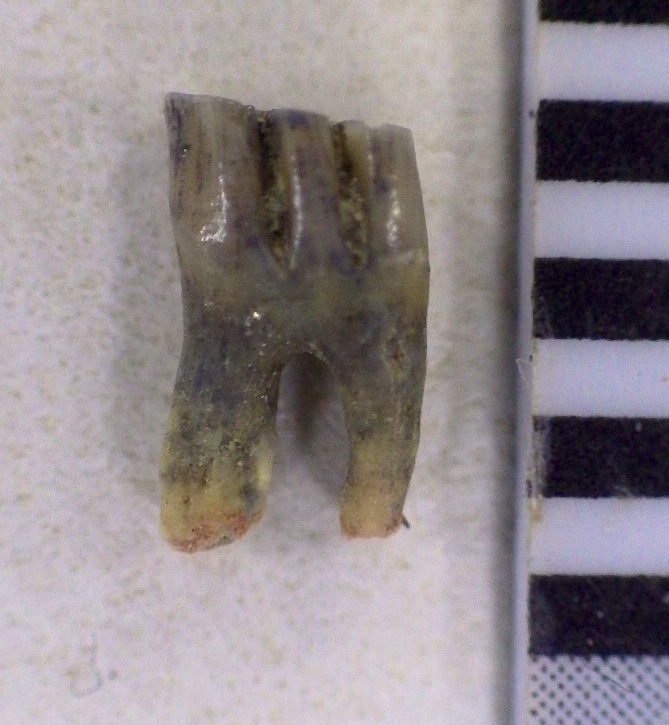 For this week's Fossil Friday I'm sticking with teeth. In contrast to last week's large camel molar, this time I chose the other end of the size spectrum with a tiny tooth that's only about 3 mm long.For all the attention that large animals receive, rodents and other small mammals are probably the most common vertebrate fossils in the Pleistocene deposits around Diamond Valley Lake. One of the more common rodents in our collection is the genus Neotoma, the packrat.Packrats (or woodrats) are in the Family Cricetidae, the same family that includes voles, lemmings, and hamsters. They shouldn't be confused with the brown rat (genus Rattus), which is what many people think of when they hear "rat". Rattus (including the white forms commonly used in laboratories) is a member of the Family Muridae. Rattus is only distantly related to the cricetids and was introduced into the Americas by humans.Packrats have a reduced dentition, with only one incisor and three molars in each half of both the upper and lower jaws. The molars have five cusps that are arranged in such a way that as they wear down they form three enamel-edged oval basins in occlusal view:
For this week's Fossil Friday I'm sticking with teeth. In contrast to last week's large camel molar, this time I chose the other end of the size spectrum with a tiny tooth that's only about 3 mm long.For all the attention that large animals receive, rodents and other small mammals are probably the most common vertebrate fossils in the Pleistocene deposits around Diamond Valley Lake. One of the more common rodents in our collection is the genus Neotoma, the packrat.Packrats (or woodrats) are in the Family Cricetidae, the same family that includes voles, lemmings, and hamsters. They shouldn't be confused with the brown rat (genus Rattus), which is what many people think of when they hear "rat". Rattus (including the white forms commonly used in laboratories) is a member of the Family Muridae. Rattus is only distantly related to the cricetids and was introduced into the Americas by humans.Packrats have a reduced dentition, with only one incisor and three molars in each half of both the upper and lower jaws. The molars have five cusps that are arranged in such a way that as they wear down they form three enamel-edged oval basins in occlusal view: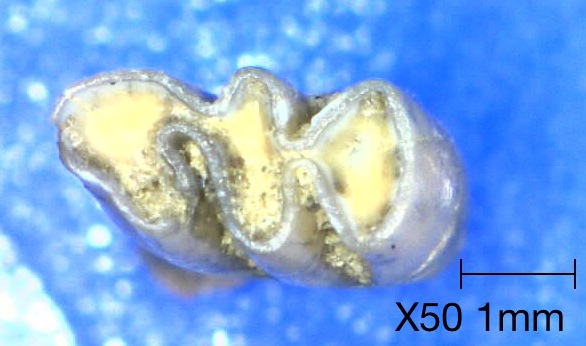 Different genera have distinctive cusp patterns, and in fact each individual tooth position has a unique, easily-identified pattern (see the images at this site). This particular tooth is the first lower right molar from Neotoma.There are a number of species of Neotoma known from California, and unfortunately the different Neotoma species are not as easily identified on the basis of an individual tooth. So, at least for now, this tooth can only be identified as Neotoma sp.
Different genera have distinctive cusp patterns, and in fact each individual tooth position has a unique, easily-identified pattern (see the images at this site). This particular tooth is the first lower right molar from Neotoma.There are a number of species of Neotoma known from California, and unfortunately the different Neotoma species are not as easily identified on the basis of an individual tooth. So, at least for now, this tooth can only be identified as Neotoma sp.






